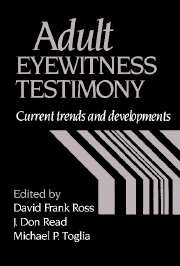Book contents
- Frontmatter
- Contents
- List of contributors
- Preface
- Part I Cognitive, physical and social processes and factors influencing eyewitness recall and identification
- Part II Lineup construction and collection of testimony
- Part III Whom to believe? Distinguishing accurate from inaccurate eyewitnesses
- 13 Distinguishing accurate from inaccurate eyewitness identifications: A reality monitoring approach
- 14 Decision times and eyewitness identification accuracy in simultaneous and sequential lineups
- 15 Individual differences in personality and eyewitness identification
- 16 Eyewitness identification confidence
- 17 Expectations of eyewitness performance: Jurors' verdicts do not follow from their beliefs
- 18 The appraisal of eyewitness testimony
- Name index
- Subject index
18 - The appraisal of eyewitness testimony
Published online by Cambridge University Press: 04 August 2010
- Frontmatter
- Contents
- List of contributors
- Preface
- Part I Cognitive, physical and social processes and factors influencing eyewitness recall and identification
- Part II Lineup construction and collection of testimony
- Part III Whom to believe? Distinguishing accurate from inaccurate eyewitnesses
- 13 Distinguishing accurate from inaccurate eyewitness identifications: A reality monitoring approach
- 14 Decision times and eyewitness identification accuracy in simultaneous and sequential lineups
- 15 Individual differences in personality and eyewitness identification
- 16 Eyewitness identification confidence
- 17 Expectations of eyewitness performance: Jurors' verdicts do not follow from their beliefs
- 18 The appraisal of eyewitness testimony
- Name index
- Subject index
Summary
With emphasis bordering on the dramatic, dozens of important articles and books on eyewitness testimony have begun by emphasizing the central, indeed pivotal, role that eyewitness testimony plays in criminal cases. This chapter will be no exception. An eyewitness report, confidently delivered, has swayed many a jury. Even more profoundly, an eyewitness influences the legal process even before the witness takes the stand in court. If there is an eyewitness, especially one who makes a positive impression, the police and prosecutor's office are more likely to pursue a case. And what the witness reports will influence the course of an investigation. When we add to these facts the research evidence that eyewitness memory is often inaccurate, we have a real potential for frequent misfires of the justice process, errors that cost money, time, and, in some cases, the freedom of an innocent person.
It is, however, decisions about eyewitness testimony, rather than the testimony itself, that lead to errors in the delivery of justice. They occur when a fact finder (a police officer, clinical interviewer, juror, or judge) believes an inaccurate witness or doubts an accurate one. As Wells (1985a) has noted, “if jurors and judges were able to discriminate meaningfully between accurate and inaccurate eyewitness testimony, our concerns about inaccurate testimony would be lessened considerably” (p. 45). In this chapter, I will be concerned with how fact finders appraise eyewitness reports. I will review research and lay some theoretical groundwork concerning how and how well people evaluate memory reports. What factors influence judgments of witness credibility and how valid are these judgments?
- Type
- Chapter
- Information
- Adult Eyewitness TestimonyCurrent Trends and Developments, pp. 385 - 418Publisher: Cambridge University PressPrint publication year: 1994
- 11
- Cited by



